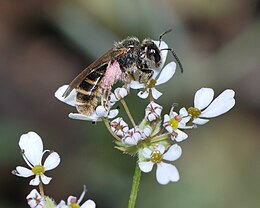Lasioglossum
| Lasioglossum | ||||||||||||
|---|---|---|---|---|---|---|---|---|---|---|---|---|

|
||||||||||||
| Systematics | ||||||||||||
|
||||||||||||
| Scientific name | ||||||||||||
| Lasioglossum | ||||||||||||
| Curtis 1833 |
Lasioglossum is the species-richest genus of bees with more than 1700 species worldwide in numerous subgenera. Together with the genus Halictus , the Lasioglossum species are referred to in German as furrow bees .
features
The species are very variable in size, color and body structure. The bees are small to medium-sized, 3.5 to 12 mm long. The native Lasioglossum species usually have a black or black-brown body. But there are also species with a metallic green, blue or bronze colored body (especially in the New World). In many species the abdomen of the males is colored red. The males are significantly slimmer than the females. The females have a collecting brush on their hind legs. There are three cubital cells in the fore wing. Just like the Halictus species, the females have a bare longitudinal furrow at the end of the abdomen, which is lined with hair. In contrast to Halictus , the Lasioglossum species do not have light-colored hair ties at the ends of the tergites, but often hair ties at the base of the segments. In addition, the wing veins are reduced in Lasioglossum .
Way of life
Most types of Lasioglossum live in social communities of different levels of development. There are solitary as well as communal and eusocial species with all intermediate levels. The fertilized females overwinter in the nests. In spring they usually raise the first brood themselves, from which workers emerge who then take on the rearing of the brood. Then, or only in a third generation, sex animals arise. Both sexes then fly together for some time until the males die and the females go to wintering quarters. Nests can be established by a single female, or by several together ( pleometrosis , often sisters, or mother and daughters, more rarely also unrelated females). Most species nest in the ground, some in rotting tree trunks ( dead wood ). The entrance to the nest is often surrounded by a small mound of earth. Most species are food generalists, i.e. polylectic.
Among the more unusual species are kleptoparasites , nocturnal flying and oligolectic (specialized in a few forage plants).
Systematics
Lasioglossum belongs in the subfamily Halictinae to the tribe Halictini. This tribe also includes the species-rich genera Halictus , Patellapis and Sphecodes .
The genus Lasioglossum can be divided into two informal series based on the strength of the distal veins of the fore wing. The Lasioglossum series consists largely of solitary or communal species. Two possible exceptions are L. aegyptiellum and L. rubricaude , both of which show signs of division of labor, which indicate eusociality .
The Hemihalictus series contains species with a wide range of social behaviors . It is composed of solitary, communal, semi-social, simply eusocial, kleptoparasitic and socially parasitic species. Eusocial species can have small colonies with just one or a few workers, or large colonies with dozens of workers. The largest colonies are found in L. marginatum , which form five to six year old colonies with hundreds of workers.
Subgenera
List of sub-genera (according to Michener):
Lasioglossum series: Australictus , Callalictus , Chilalictus , Ctenonomia , Glossalictus , Lasioglossum s. st. , Parasphecodes , Pseudochilalictus .
Hemihalictus series: Acanthalictus , Austevylaeus , Dialictus , Evylaeus , Hemihalictus , Paradialictus , Sellalictus , Sphecodogastra , Sudila .
Native species
There are 88 species in Germany, Austria and Switzerland. In Germany there are 64 species from the two sub-genera Evylaeus and Lasioglossum s. st., many species are very rare. Many species are difficult to determine, sometimes not only a stereomicroscope and a reference collection is necessary, but also genital dissection. Here are some common types (after):
- Lasioglossum albipes
- Lasioglossum calceatum
- Lasioglossum costulatum
- Lasioglossum fratellum
- Lasioglossum fulvicorne
- Lasioglossum laticeps
- Lasioglossum leucozonium
- Lasioglossum lucidulum
- Lasioglossum malachurum
- Lasioglossum morio
- Lasioglossum nitidulum
- Lasioglossum pallens
- Lasioglossum pauxillum
- Lasioglossum villosum
- Lasioglossum zonulum
Some of the better known species are the European Lasioglossum calceatum and Lasioglossum malachurum, as well as the North American Lasioglossum zephyrum and the widespread fringed narrow bee Lasioglossum marginatum , which is also found in Germany and Austria. It is the only one that has a life cycle of several years and a special caste system.
Individual evidence
- ↑ Gibbs, J., et al. (2012). Phylogeny of halictine bees supports a shared origin of eusociality for Halictus and Lasioglossum (Apoidea: Anthophila: Halictidae). Molecular Phylogenetics and Evolution 65 (3), 926-39.
- ↑ Ascher, JS and J. Pickering. 2011. Discover Life bee species guide and world checklist (Hymenoptera: Apoidea: Anthophila).
- ↑ a b E. Scheuchl & W. Willner: Pocket dictionary of wild bees in Central Europe . Source Meyer, 2016, ISBN 978-3-494-01653-5 , p. 497-592 .
- ↑ a b c d P. Westrich: The wild bees of Germany . Ulmer Verl., Stuttgart 2018, ISBN 978-3-8186-0123-2 , pp. 130-135, 532-539 .
- ↑ a b Ch. D. Michener: The Bees of the World . 2nd Edition. The Johns Hopkins Univ. Press, Baltimore 2007, pp. 70, 371-382 .
- ↑ Michener, CD (1974). The Social Behavior of the Bees . Harvard University Press. 404 pp.
- ↑ Lexicon of Biology: Schmalbienen , on: Spektrum.de, with a drawing of the nest

